
HOME / Departments / Earth and Planetary Sciences / Space and Earth Electromagnetism
Space and Earth Electromagnetism
-
- YOSHIKAWA Akimasa, Professor
- KAWANO Hideaki, Associate Professor
- The Space and Earth Electromagnetism (SEE) group studies space weather, aurora, electromagnetic fields, and plasma fluctuations in the Sun–Earth system. We have been greatly contributing to the development of the real-time Magnetic Field Data Acquisition System (MAGDAS), consisting of ground magnetometers installed around the world and the system to real-time retrieve data from the magnetometers via the Internet. On the basis of the MAGDAS network data, we are studying the electromagnetically coupled system from the Sun to the Earth. We are also studying simultaneous observations by MAGDAS and satellites in space, which also provide a very powerful approach for understanding the coupled system. We are also developing new methods of data analysis and constructing theoretical framework for understanding the Sun–Earth coupled system.
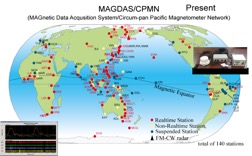
For space environment monitoring, the SEE Group has been contributing to developing a real time magnetic data acquisition system (the MAGDAS project) around the world. The number of observational sites is increasing every year with the collaboration of MAGDAS host countries. Now at this time, the MAGDAS Project has installed 77 real time magnetometers—so it is the largest magnetometer array in the world.
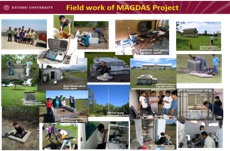
The installation and maintenance of MAGDAS are strongly supported by the cooperation of local collaborators. Many students as well as foreign partners attended field works. This MAGDAS activity has become the foundation of our capacity building activities for young scientist.
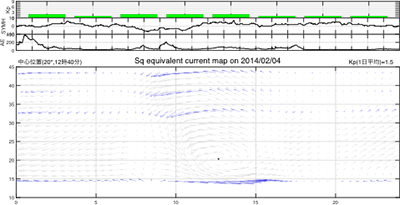
Right figure shows equivalent ionospheric current system on geomagnetically quiet day (Sq-current system) reproduced by MAGDAS data. We can identify large scale vortex-type current generated by atmospheric dynamo action. Long time scale variation of Sq-current become good indicator for climate change coupled to solar environment.
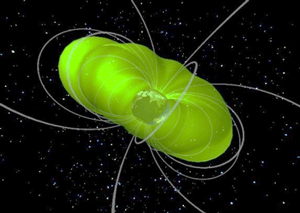
We are also estimating the plasma density in the plasmasphere (green part in the right figure; the credit of this figure belongs to NASA/Goddard Space Flight Center Scientific Visualization Studio) from the ground-magnetometer observations; to do that, we use a method derived from the MHD equations, which can estimate the density along the magnetic field line running through the ground-magnetometer location. The plasmasphere is the magnetospheric region closest to the Earth, filled with ionosphere-origin plasma which moved to the plasmasphere along the magnetic field line.
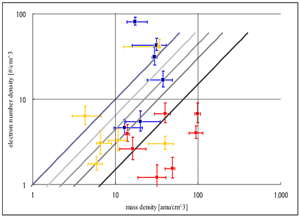
The right figure (extracted and modified from Maeda et al., 2009) is an example of densities estimated from a MAGDAS stations’ data (TIK and CHD), compared with observations by Cluster spacecraft when it was located on the same field line at the same time. The two densities are in general correlated. The slanted lines show the possible range of the mass density, and the majority of the estimated density are in this range. The red (blue) color corresponds to geomagnetically active (quiet) times, showing that there are many heavy ions in the plasmasphere during active times.
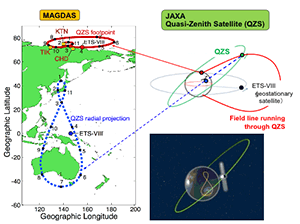
We are also studying simultaneous observations on the same field line by Siberian MAGDAS stations (TIK, KTN, and CHD) and the Quasi-Zenith Satellite (QZS) launched by JAXA. In the left panel of the right figure, the footpoint of the field line running through QZS (red) is close to TIK, KTN, and CHD, and stay there for a long time due to the orbital characteristics of QZS. By using these data, we are studying field-aligned currents and their ionospheric closure currents. (The credit of the right bottom panel belongs to JAXA.)
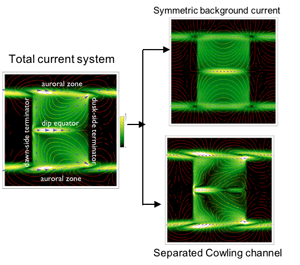
We are also theoretically studying how magnetosphere and ionosphere interact each other. Inclusive understanding of plasma dynamics in weakly ionized system coupled to collision-less domain, is frontier of space science.
Left figure numerically shows global ionospheric current circuit how auroral electrojet generated by magnetospheric dynamo is coupled to equatorial electrojet. Our developed method enable to extract the Cowling channel, which induces current concentration by Hall polarization field.